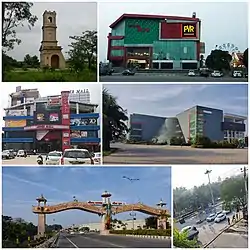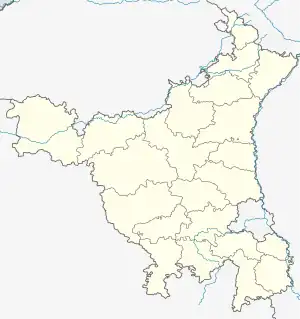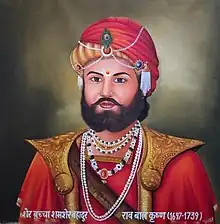Karnal | |
|---|---|
 Clockwise from top right;
K3C Mall, Agro Mall, Sector 12 road, Shrimad Bhagwad Gita Dwar, Super Mall, Cantonment Church Tower. | |
 Karnal Location in Haryana, India  Karnal Karnal (India) | |
| Coordinates: 29°41′10″N 76°59′20″E / 29.686°N 76.989°E | |
| Country | |
| State | Haryana |
| District | Karnal |
| Region | North India |
| Founded by | Raja Karna |
| Named for | Karna |
| Government | |
| • Type | Municipal Corporation |
| • Body | Municipal Corporation Karnal |
| • MLA, Chief Minister | Manohar Lal Khattar |
| • Member of Parliament | Sanjay Bhatia |
| • Mayor | Renu Bala Gupta |
| Area | |
| • Total | 87 km2 (34 sq mi) |
| Population (2011) | |
| • Total | 357,334[1][2] |
| Languages[3][4] | |
| • Official | Hindi |
| Time zone | UTC+5:30 (IST) |
| PIN | 132001 |
| Area code | 0184 |
| Vehicle registration | HR-05 |
| literacy rate | 84.60%[2] |
| Sex ratio | 996/1000 Female/Male |
| Website | karnal |
Karnal (ⓘ) is a city located in the state of Haryana, India and is the administrative headquarters of Karnal District. It was used by East India Company army as a refuge during the Indian Rebellion of 1857 in Delhi. The Battle of Karnal between Nader Shah of Persia and the Mughal Empire took place in this city in 1739.[5]
Etymology
The city associates itself with the character Karna from the Indian epic Mahabharata.[6]
History
Ancient
At the end of 6th century A.D., the area was under the rule of the Vardhanas of Thanesar.[7] The 7th century was a period of religious eclecticism, as Buddhism was declining and Hinduism was resurging in the Indo-Gangetic plains. The region was under Kanauji rule under the Pala Emperors of Bengal from 770 to 810 AD. The authority of Mihira Bhoja, the Pratihara ruler of Kanauj from 836 to 885 AD, penetrated as far as Pehowa, including Karnal.[8]
Medieval
The Tomaras, a dynasty descending from Raja Jaala, established themselves as rulers of this region in the middle of the 9th century.[8] About the beginning of the 10th century, as the Pratyahara power began to decline, the Tomaras assumed independence. One of the Tomara rulers, Amanpal Tomar, found the city of Delhi and made it his capital, with the area of Karnal and modern-day Haryana being under his realm. The Tomaras came into conflict with the Chauhan's of Shakambhari, but continued to rule the Haryana country until the middle of 12th century when they were overthrown by the Chaha mana Vighnaraja IV.[9] The country between the Satluj and the Yamuna including Karnal experienced relative peace for a century and a half except the plundering invasions and eventual conquests of Mahmud of Ghazi. The region then came under Ghurid rule after the Second Battle of Tarani when Muhammad Ghori captured the area. It remained under the Delhi Sultanate until 1526.
In 1526 at the First Battle of Panipat, Mughal emperor Babur defeated the Sultan of Delhi, Ibrahim Lodi, and captured India along with Delhi and Panipat. He then established the Mughal Empire.
Karnal is listed in the Mughal Ain-i-Akbari as a pargana under Delhi sarkar, producing a revenue of 5,678,242 dams for the imperial treasury and supplying a force of 800 infantry and 50 cavalry.[10]
_Diamond_from_the_collection_of_the_national_jewels_of_Iran_at_Central_Bank_of_Islamic_Republic_of_Iran.jpg.webp)

In A.D. 1739, Nader Shah of Persia invaded the Mughal empire and Karnal was the scene of the famed Battle of Karnal, in which Nader Shah decisively defeated the Mughal Emperor, Muhammad Shah.[11] Muhammad Shah along with an enormous army occupied a strongly fortified camp at Karnal, but he yielded to the invader as his supplies were cut off from the open country by Shah and was starved into submission.[11] The tactical defeat drastically weakened the Mughal Empire, while the Persian Empire prospered and subsequently hastened the establishment of the British Empire in India. The region then came under Afghan rule. On 24 Feb1739, the Iranian ruler Nadir Shah attacked India. Rao Bal Kishan, with his army and with the forces of Delhi, fought Nadir Shah. His army included 5000 infantry and 2000 cavalry. In February 1739, Nader Shah captured Sirhind and moved towards the field of Karnal, a battle destined to be fateful to the Mughal rulers. Every year on 24 Feb, Rao Bal Kishan Shaurya Diwas celebrated in Rewari.[12][13]
Sikhs appeared on the scene in the 18th century. The importance of Karnal grew in the time of Raja Gajpat Singh of Jind State who after its capture in A.D. 1763 built the boundary wall and a fort and under whose rule the town increased considerably in size.[14] On 14 January 1764, Sikh Chiefs defeated and killed Zain Khan Sirhindi, the Durrani Governor, and took possession of the whole of Sirhind province as far south as Panipat including Karnal.
Modern
During the Indian independence movement, a district political conference was organized at Karnal with Lala Lajpat Rai as its chairman.
Climate
| Climate data for Karnal (1981–2010, extremes 1949–2012) | |||||||||||||
|---|---|---|---|---|---|---|---|---|---|---|---|---|---|
| Month | Jan | Feb | Mar | Apr | May | Jun | Jul | Aug | Sep | Oct | Nov | Dec | Year |
| Record high °C (°F) | 31.2 (88.2) |
33.2 (91.8) |
37.5 (99.5) |
45.2 (113.4) |
46.0 (114.8) |
45.6 (114.1) |
43.9 (111.0) |
42.0 (107.6) |
38.3 (100.9) |
39.3 (102.7) |
34.4 (93.9) |
28.5 (83.3) |
46.0 (114.8) |
| Mean daily maximum °C (°F) | 19.1 (66.4) |
22.4 (72.3) |
27.7 (81.9) |
35.3 (95.5) |
38.3 (100.9) |
37.9 (100.2) |
33.9 (93.0) |
32.8 (91.0) |
32.5 (90.5) |
31.7 (89.1) |
27.4 (81.3) |
21.8 (71.2) |
30.1 (86.2) |
| Mean daily minimum °C (°F) | 7.1 (44.8) |
9.4 (48.9) |
13.5 (56.3) |
18.8 (65.8) |
23.3 (73.9) |
25.5 (77.9) |
25.6 (78.1) |
25.1 (77.2) |
23.2 (73.8) |
17.4 (63.3) |
12.0 (53.6) |
8.0 (46.4) |
17.4 (63.3) |
| Record low °C (°F) | −0.3 (31.5) |
0.6 (33.1) |
3.5 (38.3) |
9.0 (48.2) |
14.5 (58.1) |
18.0 (64.4) |
16.0 (60.8) |
18.4 (65.1) |
16.0 (60.8) |
9.4 (48.9) |
3.0 (37.4) |
−0.4 (31.3) |
−0.4 (31.3) |
| Average rainfall mm (inches) | 26.7 (1.05) |
24.8 (0.98) |
17.8 (0.70) |
8.4 (0.33) |
24.2 (0.95) |
65.7 (2.59) |
171.8 (6.76) |
157.5 (6.20) |
115.9 (4.56) |
3.5 (0.14) |
1.9 (0.07) |
9.0 (0.35) |
627.1 (24.69) |
| Average rainy days | 1.5 | 1.8 | 1.6 | 0.9 | 1.6 | 3.9 | 7.9 | 7.8 | 4.7 | 0.2 | 0.4 | 0.8 | 33.2 |
| Average relative humidity (%) (at 17:30 IST) | 64 | 58 | 51 | 31 | 33 | 44 | 67 | 73 | 68 | 54 | 53 | 60 | 55 |
| Source: India Meteorological Department[15][16] | |||||||||||||
Demographics
The population of the city as of 2011, is 357,334[1][2]

| Religion | Population (1911)[17]: 20 |
Percentage (1911) |
Population (1941)[18]: 30 |
Percentage (1941) |
|---|---|---|---|---|
| Hinduism |
12,772 | 58.16% | 20,462 | 54.65% |
| Islam |
8,667 | 39.47% | 15,844 | 42.31% |
| Sikhism |
13000 | 0.59% | 647 | 1.73% |
| Christianity |
210 | 0.96% | 125 | 0.33% |
| Others [lower-alpha 2] | 182 | 0.83% | 366 | 0.98% |
| Total Population | 21,961 | 100% | 37,444 | 100% |
Politics
The city is part of the Karnal Assembly constituency and Manohar Lal Khattar is the MLA from Karnal constituency.[19]
Sanjay Bhatia is the current elected MP from the Karnal Lok Sabha constituency.
Facilities
Karnal was ranked 24th (1st in Haryana) among 4000+ cities in the list of the cleanest cities of India under the government survey named Swachh Survekshan 2019.[20]
Karnal was selected as one of the hundred Indian cities to be developed as a smart city under the Union government's plan Smart Cities Mission.[21]
Education
Notable people
- Kalpana Chawla, first Indo-American woman astronaut. In 2003, Chawla was one of the seven crew members that died in the Space Shuttle Columbia disaster[27]
- Vikramjeet Virk A Bollywood Actor. He Was Born in 1984 Village Tharwa Majra Of Karnal. He’s Well Renowned Actor Working in Hindi, Punjabi, Telugu Films.
- Anish Bhanwala, Indian shooter. He was brought up in Karnal, Haryana and competes in the 25 meter rapid fire pistol, 25 meter pistol, and 25 meter standard pistol events.[28]
- Mool Chand Jain, a leader of the Indian Independence movement.[29]
- General Arthur Power Palmer, Commander-in-Chief of India was born in 1840
- Navdeep Saini, Indian cricketer
- Liaquat Ali Khan, was born in Karnal. A Pakistan Movement leader, he was selected as the first Prime Minister of Pakistan by Quaid e Azam Muhammad Ali Jinnah[30]
Notes
- ↑ 1941 census: Including Ad-Dharmis
- ↑ Including Jainism, Buddhism, Zoroastrianism, Judaism, others, or not stated
References
- 1 2 3 "Karnal City". Archived from the original on 1 November 2020. Retrieved 7 April 2016.
- 1 2 3 "Karnal (M Cl)". censusindia.gov.in. Government of India. Retrieved 7 April 2016.
- ↑ "Report of the Commissioner for linguistic minorities: 52nd report (July 2014 to June 2015)" (PDF). Commissioner for Linguistic Minorities, Ministry of Minority Affairs, Government of India. pp. 85–86. Archived from the original (PDF) on 15 November 2016. Retrieved 24 March 2019.
- ↑ IANS (28 January 2010). "Haryana grants second language status to Punjabi". Hindustan Times. Retrieved 24 March 2019.
- ↑ "History about the city of Karnal". Government of Karnal. Retrieved 7 February 2022.
- ↑ King Karna returns to his land — Karnal. Mythology inspires ambitions, a larger-than-life portrayal of past events in order to add awe, plus a few nickels to the government kitty by way of tourism.
- ↑ D. C. Ganguly (1981). "Western India in the Sixth Century A.D.". In R. C. Majumdar (ed.). A Comprehensive History of India. Vol. 3, Part I: A.D. 300-985. Indian History Congress / People's Publishing House. OCLC 34008529.
- 1 2 H. A. Phadke (1990). Haryana, Ancient and Medieval. Harman. ISBN 978-81-85151-34-2.
- ↑ R. B. Singh (1964). History of the Chāhamānas. N. Kishore. OCLC 11038728.
- ↑ Abu'l-Fazl ibn Mubarak; Jarrett, Henry Sullivan (translator) (1891). The Ain-i-Akbari. Calcutta: Asiatic Society of Bengal. p. 286. Retrieved 21 January 2021.
{{cite book}}:|first2=has generic name (help) - 1 2 Axworthy, Michael (2009)
- ↑ Haryana State Gazetteer. Haryana Gazetteers Organisation, Revenue Department. 2001.
- ↑ https://www.bhaskar.com/local/haryana/rohtak/rewari/news/martyrs-day-of-veer-amar-shaheed-rao-balkishan-celebrated-in-nangal-pathani-128254998.html.
{{cite news}}: Missing or empty|title=(help) - ↑ D. C. Miglani (1993). Politics and Rural Power Struggle: Emerging Trends. Deep and Deep Publications. ISBN 81-7100-578-0.
- ↑ "Station: Karnal Climatological Table 1981–2010" (PDF). Climatological Normals 1981–2010. India Meteorological Department. January 2015. pp. 395–396. Archived from the original (PDF) on 5 February 2020. Retrieved 1 March 2020.
- ↑ "Extremes of Temperature & Rainfall for Indian Stations (Up to 2012)" (PDF). India Meteorological Department. December 2016. p. M65. Archived from the original (PDF) on 5 February 2020. Retrieved 1 March 2020.
- ↑ "Census of India 1911. Vol. 14, Punjab. Pt. 2, Tables". Retrieved 21 August 2022.
- ↑ "CENSUS OF INDIA, 1941 VOLUME VI PUNJAB PROVINCE". Retrieved 21 August 2022.
- ↑ "Manohar Lal Khattar in Karnal Election Results 2019: Manohar Lal Khattar of BJP Wins". News18. 24 October 2019. Retrieved 4 February 2022.
- ↑ "Cleanliness survey: Karnal city needs toilets to improve rank". The Tribune. 17 March 2019. Retrieved 21 March 2019.
- ↑ "Khattar's Karnal tops list of smart cities". Tribune. 23 July 2015. Retrieved 29 January 2021.
- ↑ "Education – NDRI-National Dairy Research Institute (Deemed University)". Retrieved 12 August 2022.
- ↑ , official website.
- ↑ Kalpana Chawla Government Medical College
- ↑ , official website.
- ↑ Maharana Pratap Horticultural University, Karnal, official website.
- ↑ "Only 98 cities instead of 100 announced: All questions answered about the smart cities project". 28 August 2015.
- ↑ "Anish wins India's third individual gold in Jr. World Cup". Business Standard India. Press Trust of India. 26 March 2018.
- ↑ "Babu Mool Chand Jain Comprehensive Archives".
- ↑ "Liaquat Ali Khan prime minister of Pakistan". 24 November 2023.